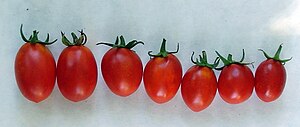Pomodorino di Manduria
| Pomodorino di Manduria | |
|---|---|
 | |
| Tomato (Solanum lycopersicum) | |
| Color | Red |
Pomodorino di Manduria is an ecotype of tomato typical of Manduria, a city in the province of Taranto. In the local dialect, it is also called "pummitoru paisanu".
Origins[edit]
Tomatoes are used in many Apulian traditional dishes, such as friselle or some typical recipe with pasta, meat and fish. The region hosts at least four traditional varieties of tomato.
Characteristics[edit]
These tomatoes are cultivated in little plots of land (1/2–2 hectares). They are sown in March and harvested from the second half of June to the first days of September.[1] This ecotype does not need any trimming or pruning operation. The fruit weight is between 10 and 25 grams.
From some researches, it has been discovered that this ecotype is very resistant to the tomato spotted wilt orthotospovirus (TSWV) and with a graft that this tolerance is also transmitted to other varieties.[2][3]
This table is about dried tomatoes in oil (for 100 grams).
| Water | Protein | Fat | Carbohydrate | Fiber | Energy Value |
|---|---|---|---|---|---|
| 57 | 5 | 14 | 17 | 5 | 214 kcal[4] |
Geography[edit]
Pomodorino di Manduria is grown in Manduria and Maruggio and, to a lesser extent, also in Sava, Avetrana and Lizzano. These cities and villages are located in deep loamy territories called Terre ti patuli. Near the Ionian Sea in the areas of San Pietro in Bevagna and Campomarino, the tomatoes are cultivated without the need for irrigation, while in the inland called "Terre rosse", two-three irrigation operations are needed in June.
Cuisine[edit]
Tomatoes are eaten fresh during summer with friselle or in salads with the barattiere di Manduria. Another use is for the production of the homemade tomato sauce or for making the dried tomatoes in oil. The main typical recipe is the "Jatedda", a salad with fresh tomatoes, garlic, "Terra d'Otranto" extra-virgin olive oil, salt, capers and oregano; usually it is served with slices of homemade dry bread.
Designation of origin[edit]
The Italian Ministry of Agricultural, Food and Forestry Policies has recognised pomodorino di Manduria as prodotto agroalimentare tradizionale (PAT) of Apulia.[5]
See also[edit]
Other articles of the topic Italy : Spaghetti Western
Other articles of the topic Food : Honey, Starbucks Corporation, Kreplach
Some use of "" in your query was not closed by a matching "".Some use of "" in your query was not closed by a matching "".
References[edit]
- ↑ "Manduria Cherry Tomato". fondazioneslowfood.com. Retrieved 10 December 2024.
- ↑ Spanò, Roberta; Mascia, Tiziana; Kormelink, Richard; Gallitelli, Donato (2015-10-23). "Grafting on a Non-Transgenic Tolerant Tomato Variety Confers Resistance to the Infection of a Sw5-Breaking Strain of Tomato spotted wilt virus via RNA Silencing". PLOS ONE. 10 (10): e0141319. Bibcode:2015PLoSO..1041319S. doi:10.1371/journal.pone.0141319. ISSN 1932-6203. PMC 4619829. PMID 26496695.
- ↑ "Pomodoro di Manduria tollerante al Tomato Spotted Wilt Virus". BiodiverSO (in italiano). 2014-08-18. Retrieved 2018-08-03.
- ↑ Regione Puglia, Assessorato Risorse Agroalimentari (2006). Atlante dei prodotti tipici agroalimentari di Puglia. Modugno (Bari): Edit. p. 91. Search this book on

- ↑ Tredicesima revisione dell'elenco dei prodotti agroalimentari tradizionali Archived 27 September 2013 at the Wayback Machine (in Italian). Rome: Ministero delle politiche agricole alimentari e forestali. Accessed June 2014.
This article "Pomodorino di Manduria" is from Wikipedia. The list of its authors can be seen in its historical and/or the page Edithistory:Pomodorino di Manduria. Articles copied from Draft Namespace on Wikipedia could be seen on the Draft Namespace of Wikipedia and not main one.

